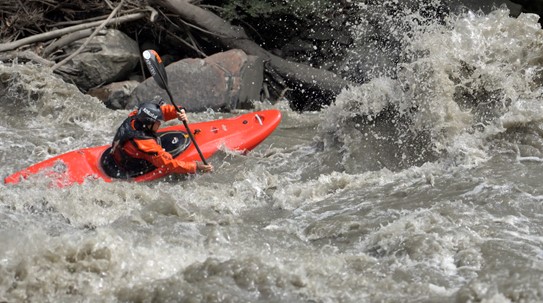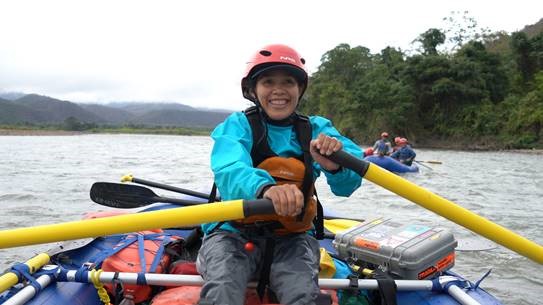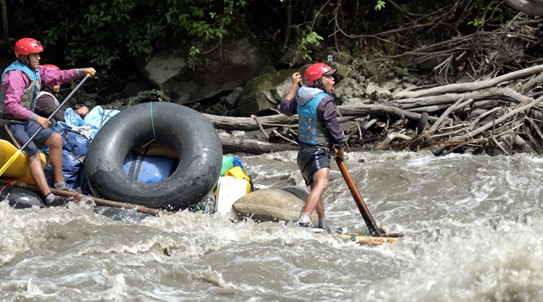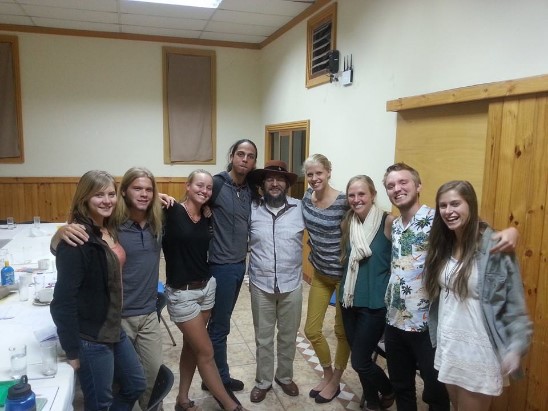Activism on film
July 20th, 2018 | SIT Study Abroad
Three SIT alumnae film an expedition down Bolivia’s Tuichi River to aid indigenous activists

It started as a joking suggestion. Why not, said Hayley Stuart, Courtney Blackmer-Reynolds, and Shaya Christensen, make an all-women documentary? The three were students with SIT Bolivia: Multiculturalism, Globalization, and Social Change in fall 2014, studying documentary filmmaking. All three were producing short films for their Independent Study Projects (ISPs), researching the issues of indigenous people and the Amazon region.
Shaya, a 2018 Middlebury College grad, explains that “Hayley did her ISP on a mega dam project, and she had her eye on similar projects in the Amazon. She had contacts from her ISP work around the hydroelectric projects. With those connections, our idea ended up blossoming into our current project.”
That project, whose working title is Still River, Silent Jungle, involves a filmmaking and whitewater kayaking expedition down Bolivia’s Tuichi River aimed at raising awareness and aiding conservation of Bolivia’s Madidi National Park. Shaya is quick to point out that the team places tremendous importance on something they learned as part of SIT Bolivia — the Andean concept of “ayni,” or reciprocity.
“It’s a common concept in many indigenous cultures,” Shaya says. “We talked about that throughout the semester with SIT and in the context of research. Even documentary film work can be extractive and not something that gives back. We talked a lot about how to avoid that. We asked, ‘What is it doing for the people you’re working with and researching?’”

Shaya, Hayley, and Courtney took those lessons to heart. They’ve sought to work directly with indigenous Amazonian communities, particularly with activist movements that oppose building dams in the region. Shaya says, “We have a strong relationship with the leaders of the coalitions fighting the dams. They’ve been amazingly helpful, and they seem really excited about the project.”
The group is giving back in tangible ways as well. “NRS [Northwest River Supplies] donated a raft and flotation devices. The raft is going to accompany the kayakers down the river and carry some national park guards. There will also be a team offering rescue courses to park guards. After filming, we’re going to donate the raft so they can monitor illegal gold mining and logging.”
The expedition will also include a team collecting data for Adventure Science’s global pollinators project.
The issue of hydroelectric dams is widespread, Shaya says. Though such projects sound good, with their focus on renewable energy, “they cause a lot of environmental damage, and often they’re servicing the more privileged population within a country. Our goal is to create a multilingual film that can be used widely by activists, and especially by the coalitions in the Amazon fighting these mega-dams.”
The film will also emphasize positive alternatives to hydroelectric projects, particularly ecotourism, which they hope will directly benefit the communities along the banks of the Tuichi.
The trio’s immediate goal is a 15- to 20-minute short version of Still River, Silent Jungle to use as a fundraising platform aimed at completion of a feature-length version they can, with luck, distribute and place in film festivals.

Shaya wants to pursue filmmaking, and she’s very clear where that idea came from. “SIT inspired me to end up working in film. The summer after I studied in Bolivia, I ended up being an archival research assistant for the Mississippi Freedom Schools. It turned out the director of that knew [SIT Bolivia film teacher] Ismael Saavedra, and had even been an SIT program director in Cuba. A director named Kathryn Murphy was working on a film about the Freedom Schools, and I ended up in a position with her working on a film about a Nicaraguan literacy project.”
While she continues that film work, Shaya is also doing refugee services casework for Denver, Colorado nonprofit Hope Communities. For her, SIT proved a great starting point not only for thinking about social justice issues but also for gaining the know-how to take action.
“The ISP was a really cool part of the SIT experience,” she says. “The freedom to go anywhere in a country to do research was pretty incredible. We had a retreat at the end of the semester, and it turned out that 20 out of the 24 students didn’t write a traditional research paper. There were eight documentaries, an art gallery by a painter, and some people wrote children’s books that were translated into the local language.”

In Bolivia, she says, take-to-the-streets activism was a regular part of life. “Probably once a week, downtown Cochabamba was shut down because of a strike, and there were a lot of gatherings in one particular plaza. It was powerful to see that day-to-day embodiment of the way that social movements form and are enacted there — all while we were talking about it in the classroom with historians and with leaders of some of these movements. It was truly a powerful experience.”
